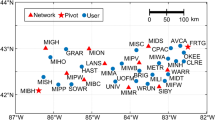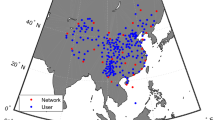Abstract
PPP-RTK combines the advantages of both precise point positioning (PPP) and real-time kinematic (RTK) techniques. While constructing PPP-RTK models based on undifferenced and uncombined observations offers apparent benefits, these observation equations suffer from a rank deficiency issue. To address this problem, the Singularity-system (S-system) theory can be utilized. This theory imposes constraints on a minimal subset of parameters, known as the S-basis, by setting them to arbitrary values, typically zeros. Despite the existence of multiple options for the S-basis, prevailing research conventionally selects the parameters of one receiver—the pivot—as the S-basis. In this study, we depart from this practice by selecting the mean of receiver-related parameters as the S-basis. This departure prompts an exploration into how the S-basis choices influence PPP-RTK outcomes regarding network product precision and user positioning performance. Our comparative analysis of the mean receiver (MR) and pivot receiver (PR) models unveils distinctions in the combined product precision. These products include satellite clocks, satellite phase biases, and ionospheric delays (excluding tropospheric delays). The distinction emerges because the estimable satellite clocks in the PR model incorporate atmospheric delays specific to the pivot receiver, in contrast to the MR model, which integrates mean atmospheric delays from all receivers. Despite the distinction in the analytical form of combined product and its precision, both model results in similar positioning performance. This is because variations in product precision levels caused by selecting different atmospheric parameters as the S-basis can be nullified by the parameterized atmospheric delays on the user side. With the inclusion of tropospheric delays, the PR and MR models also demonstrate similar performance and yield more accurate user positioning when located near the pivot receiver compared to positions farther from the pivot receiver when employing ambiguity-float network products. This dependence on the pivot receiver stems from both models selecting the pivot receiver ambiguities as the S-basis, while opting for mean ambiguities across all receivers negates the integer nature of ambiguities. Our conclusion underscores that identical positioning outcomes in PR and MR PPP-RTK models rely on both models selecting the same ambiguities as the S-basis. This highlights the potential variability in PPP-RTK performance when different ambiguity parameters are selected as the S-basis, particularly in the absence of network integer ambiguity resolution.













Similar content being viewed by others
Data availability
The data used in this study are available from the National Geodetic Survey (NGS) network (https://geodesy.noaa.gov/CORS/).
References
Baarda W (1973) S-transformations and criterion matrices. In: Publications on geodesy, 18, vol 5, no 1. Netherlands Geodetic Commission, Delft, The Netherlands.
Collins P, Bisnath S, Lahaye F, Héroux P (2010) Undifferenced GPS ambiguity resolution using the decoupled clock model and ambiguity datum fixing. Navigation 57(2):123–135. https://doi.org/10.1002/j.2161-4296.2010.tb01772.x
Ge M, Gendt G, Ma R, Shi C, Liu J (2008) Resolution of GPS carrier-phase ambiguities in precise point positioning (PPP) with daily observations. J Geodesy 82(7):389–399. https://doi.org/10.1007/s00190-007-0187-4
Grafarend E, Schaffrin B (1976) Equivalence of estimable quantities and invariants in geodetic networks. Zeitschrift Vermessungswes 101(11):485–492
Hou P, Zhang B (2023) Decentralized GNSS PPP-RTK. J Geodesy 97(72):1–18
Khodabandeh A, Teunissen P (2015) An analytical study of PPP-RTK corrections: precision, correlation and user-impact. J Geodesy 89(11):1109–1132. https://doi.org/10.1007/s00190-015-0838-9
Khodabandeh A, Teunissen PJG (2016) PPP-RTK and inter-system biases: the ISB look-up table as a means to support multi-system PPP-RTK. J Geodesy 90(9):837–851
Koch K-R (1999) Parameter estimation and hypothesis testing in linear models. Springer, Berlin
Kouba J, Héroux P (2001) Precise point positioning using IGS orbit and clock products. GPS Solutions 5(2):12–28
Laurichesse D, Mercier F, Berthias JP, Broca P, Cerri L (2009) Integer ambiguity resolution on undifferenced GPS phase measurements and its application to PPP and satellite precise orbit determination. Navigation 56(2):135–149. https://doi.org/10.1002/j.2161-4296.2009.tb01750.x
Liu T, Yuan Y, Zhang B, Wang N, Tan B, Chen Y (2017) Multi-GNSS precise point positioning (MGPPP) using raw observations. J Geodesy 91(3):253–268
Odijk D (2002) Fast precise GPS positioning in the presence of ionospheric delays. In: Publications on Geodesy, 52, Netherlands Geodetic Commission, Delft, The Netherlands.
Odijk D, Teunissen PJG, Zhang B (2012) Single-frequency integer ambiguity resolution enabled GPS precise point positioning. J Surv Eng 138(4):193–202
Odijk D, Zhang B, Khodabandeh A, Odolinski R, Teunissen PJG (2016) On the estimability of parameters in undifferenced, uncombined GNSS network and PPP-RTK user models by means of S-system theory. J Geodesy 90(1):15–44. https://doi.org/10.1007/s00190-015-0854-9
Psychas D, Verhagen S, Teunissen P (2020) Precision analysis of partial ambiguity resolution-enabled PPP using multi-GNSS and multi-frequency signals. Adv Space Res 66(9):2075–2093
Psychas D, Teunissen PJG, Verhagen S (2021) A multi-frequency Galileo PPP-RTK convergence analysis with an emphasis on the role of frequency spacing. Remote Sens 13(16):3077. https://doi.org/10.3390/rs13163077
Rizos C (2009) Network RTK research and implementation-a geodetic perspective. J Glob Position Syst 1(2):144–150
Schönemann E, Becker M, Springer T (2011) A new approach for GNSS analysis in a multi-GNSS and multi-signal environment. J Geodetic Sci 1(3):204–214. https://doi.org/10.2478/v10156-010-0023-2
Steigenberger P et al (2015) Galileo orbit and clock quality of the IGS multi-GNSS experiment. Adv Space Res 55(1):269–281
Teunissen PJG (1985) Generalized inverses, adjustment, the datum problem and S-transformations. In: Grafarend EW, Sanso F (eds) Optimization of geodetic networks. Springer, Berlin
Teunissen PJG (1995) The least-squares ambiguity decorrelation adjustment: a method for fast GPS integer ambiguity estimation. J Geodesy 70(1):65–82
Teunissen PJG, Montenbruck O (2017) Springer handbook of global navigation satellite systems. Springer, Berlin
Teunissen PJG, Odijk D, Zhang B (2010) PPP-RTK: results of CORS network-based PPP with integer ambiguity resolution. J Aeronaut Astronaut Aviat Ser a 42(4):223–230
Verhagen S, Teunissen PJ (2013) The ratio test for future GNSS ambiguity resolution. GPS Solutions 17(4):535–548. https://doi.org/10.1007/s10291-012-0299-z
Wielgosz P, Kashani I, Grejner-Brzezinska D (2005) Analysis of long-range network RTK during a severe ionospheric storm. J Geodesy 79(9):524–531
Wübbena G, Schmitz M, Bagge A (2005) PPP-RTK: precise point positioning using state-space representation in RTK networks. Paper presented at the Proc. ION GNSS 2005, The Institute of Navigation, Long Beach, CA, September 13–16
Yang Y, Gao W, Guo S, Mao Y, Yang Y (2019) Introduction to BeiDou-3 navigation satellite system. NAVIGATION J Inst Navig 66(1):7–18
Zha J, Zhang B, Liu T, Hou P (2021) Ionosphere-weighted undifferenced and uncombined PPP-RTK: theoretical models and experimental results. GPS Solutions 25(4):1–12. https://doi.org/10.1007/s10291-021-01169-0
Zhang B, Teunissen PJ, Odijk D (2011) A novel un-differenced PPP-RTK concept. J Navig 64(S1):S180–S191. https://doi.org/10.1017/S0373463311000361
Zhang B, Chen Y, Yuan Y (2019) PPP-RTK based on undifferenced and uncombined observations: theoretical and practical aspects. J Geodesy 93(7):1011–1024
Zumberge J, Heflin M, Jefferson D, Watkins M, Webb F (1997) Precise point positioning for the efficient and robust analysis of GPS data from large networks. J Geophys Res Solid Earth 102(B3):5005–5017
Acknowledgements
The authors would like to thank Prof. Peter Teunissen, Dr. Amir Khodabandeh, Dr. Robert Odolinski, Dr. Cheng Ke, and two anonymous reviewers for their insightful and constructive comments.
Funding
This work was funded by the National Natural Science Foundation of China (Grant Nos. 42022025, 42304038, 42004016). This work was supported by the Science and Technology Innovation Program of Hunan Province, China (No. 2023RC3217). This work was also supported by the Hubei International Science and Technology Cooperation Project “Research and Development of Key Technologies of Multi-data Positioning System in Middle and low Latitude Areas” (No. 2023EHA004). The corresponding author is supported by the CAS Pioneer Hundred Talents Program.
Author information
Authors and Affiliations
Contributions
B.Z. initiated the idea, designed the research, and revised the manuscript. P.H. processed the data, analyzed the results, and drafted the manuscript. F.Y. analyzed the results and revised the manuscript. J.Z. checked all the equations and analyzed the results. Y.L. and C.S. revised the manuscript and provided suggestions for improvements.
Corresponding author
Ethics declarations
Competing interests
The authors declare no competing interests.
Consent for publication
All authors read and approved the final manuscript to be published. We agree to be accountable for all aspects of the work in ensuring that questions related to the accuracy or integrity of any part of the work are appropriately investigated and resolved.
Additional information
Publisher's Note
Springer Nature remains neutral with regard to jurisdictional claims in published maps and institutional affiliations.
Appendix: Proof of (27)
Appendix: Proof of (27)
According to the definitions in Table 2, the sum of estimable satellite clocks and satellite phase biases of the MR model can be written as
where the items with an overline represent the mean of these receiver-related parameters, e.g., \(d\overline{t}_{r} = \frac{1}{n}\sum\limits_{r = 1}^{n} {d\overset{\lower0.5em\hbox{$\smash{\scriptscriptstyle\frown}$}}{t}_{r} }\).
Considering that
we obtain
from which (27) follows.
Rights and permissions
Springer Nature or its licensor (e.g. a society or other partner) holds exclusive rights to this article under a publishing agreement with the author(s) or other rightsholder(s); author self-archiving of the accepted manuscript version of this article is solely governed by the terms of such publishing agreement and applicable law.
About this article
Cite this article
Hou, P., Ye, F., Liu, Y. et al. A comparison of two PPP-RTK models: S-basis choice, network product precision, and user positioning performance. GPS Solut 28, 90 (2024). https://doi.org/10.1007/s10291-024-01635-5
Received:
Accepted:
Published:
DOI: https://doi.org/10.1007/s10291-024-01635-5




